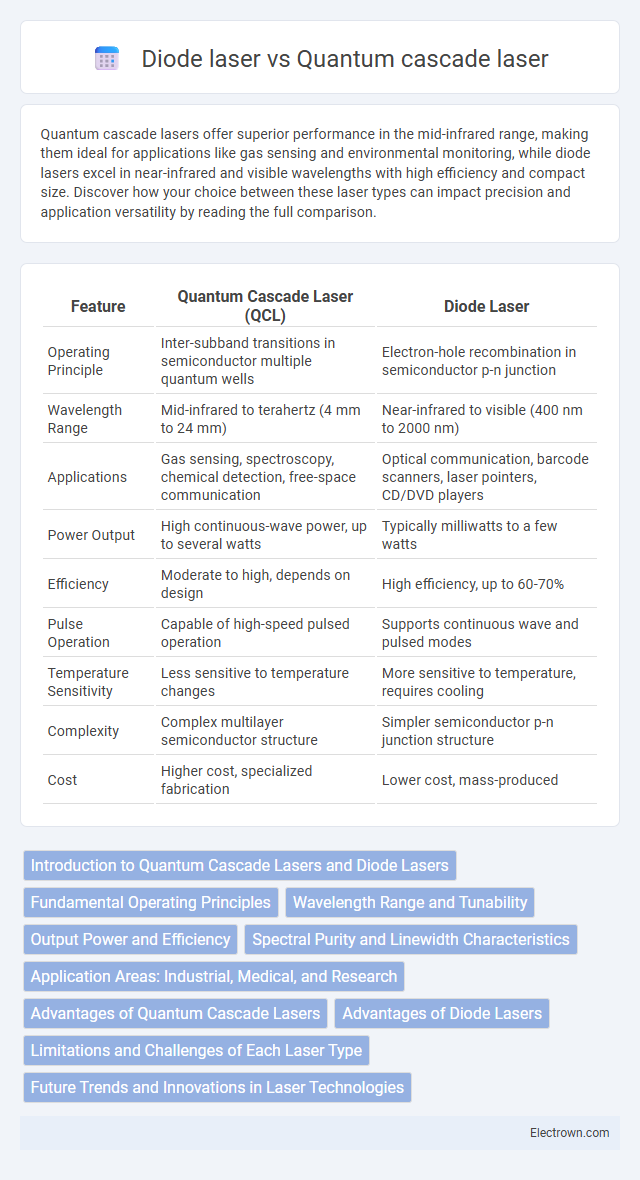Quantum cascade lasers offer superior performance in the mid-infrared range, making them ideal for applications like gas sensing and environmental monitoring, while diode lasers excel in near-infrared and visible wavelengths with high efficiency and compact size. Discover how your choice between these laser types can impact precision and application versatility by reading the full comparison.
Table of Comparison
| Feature | Quantum Cascade Laser (QCL) | Diode Laser |
|---|---|---|
| Operating Principle | Inter-subband transitions in semiconductor multiple quantum wells | Electron-hole recombination in semiconductor p-n junction |
| Wavelength Range | Mid-infrared to terahertz (4 mm to 24 mm) | Near-infrared to visible (400 nm to 2000 nm) |
| Applications | Gas sensing, spectroscopy, chemical detection, free-space communication | Optical communication, barcode scanners, laser pointers, CD/DVD players |
| Power Output | High continuous-wave power, up to several watts | Typically milliwatts to a few watts |
| Efficiency | Moderate to high, depends on design | High efficiency, up to 60-70% |
| Pulse Operation | Capable of high-speed pulsed operation | Supports continuous wave and pulsed modes |
| Temperature Sensitivity | Less sensitive to temperature changes | More sensitive to temperature, requires cooling |
| Complexity | Complex multilayer semiconductor structure | Simpler semiconductor p-n junction structure |
| Cost | Higher cost, specialized fabrication | Lower cost, mass-produced |
Introduction to Quantum Cascade Lasers and Diode Lasers
Quantum cascade lasers (QCLs) operate based on intersubband transitions within semiconductor superlattices, emitting in the mid-infrared to terahertz range, making them ideal for chemical sensing and spectroscopy. Diode lasers utilize electron-hole recombination across the semiconductor bandgap, typically emitting in the near-infrared to visible spectrum, widely used in telecommunications, barcode scanning, and laser pointers. The distinct operating principles and emission wavelengths of QCLs and diode lasers define their specific applications and performance characteristics in photonic technologies.
Fundamental Operating Principles
Quantum cascade lasers (QCLs) emit mid- to far-infrared light through intersubband transitions within multiple quantum wells, utilizing electron cascading for photon generation in a unipolar semiconductor structure. Diode lasers rely on electron-hole recombination across the bandgap of a semiconductor material, producing near-infrared to visible light through bipolar conduction mechanisms. Understanding these fundamental operating principles helps you select the appropriate laser type for applications requiring specific wavelengths and efficiencies.
Wavelength Range and Tunability
Quantum cascade lasers (QCLs) operate primarily in the mid- to far-infrared wavelength range, typically from 4 to 12 micrometers, offering highly specific tunability for applications like gas sensing and spectroscopy. Diode lasers cover a broader spectrum, spanning from near-ultraviolet to near-infrared wavelengths (around 400 to 1700 nanometers), with limited but faster tunability mainly used in telecommunications and barcode scanning. Your choice depends on the required wavelength range and tuning precision, with QCLs excelling in mid-infrared selectivity and diode lasers providing compact versatility in shorter wavelengths.
Output Power and Efficiency
Quantum cascade lasers (QCLs) offer higher output power, typically ranging from several watts to tens of watts in mid-infrared wavelengths, compared to diode lasers that usually deliver milliwatt to watt-level output in near-infrared bands. QCLs exhibit superior wall-plug efficiency, often exceeding 10-15%, due to their unipolar design enabling efficient intersubband transitions, while diode lasers generally reach efficiencies around 30-50% but at lower power densities. The efficiency and output power advantages of QCLs make them ideal for applications requiring high-power mid-infrared sources such as spectroscopy and chemical sensing.
Spectral Purity and Linewidth Characteristics
Quantum cascade lasers exhibit superior spectral purity and narrower linewidths compared to diode lasers, making them ideal for applications demanding precise wavelength control. Their intersubband transition mechanism in semiconductor heterostructures enables emission in the mid-infrared range with minimal spectral broadening. Diode lasers typically display broader linewidths due to carrier-induced refractive index fluctuations and temperature variations, limiting their use in high-resolution spectroscopy.
Application Areas: Industrial, Medical, and Research
Quantum cascade lasers (QCLs) dominate industrial applications requiring mid-infrared spectroscopy, such as gas sensing and environmental monitoring, due to their tunable wavelengths and high power. Diode lasers excel in medical fields like ophthalmology and dermatology by providing precise, compact, and efficient light sources for imaging and treatment. In research, QCLs enable advanced molecular spectroscopy and chemical analysis while diode lasers support a broad range of experiments requiring visible to near-infrared wavelengths.
Advantages of Quantum Cascade Lasers
Quantum cascade lasers (QCLs) offer superior wavelength tunability in the mid-infrared range compared to diode lasers, allowing precise targeting for applications like gas sensing and spectroscopy. Their high power output and continuous wave operation at room temperature provide increased efficiency and stability for industrial and medical uses. Your choice of QCLs ensures access to a versatile laser source with excellent spectral control and durability in demanding environments.
Advantages of Diode Lasers
Diode lasers offer significant advantages over quantum cascade lasers, including higher electrical efficiency and more compact size, making them ideal for portable and low-power applications. They operate efficiently in the near-infrared to visible spectrum, providing versatility for telecommunications, barcode scanning, and laser printing. Your choice of diode lasers ensures lower cost and simpler fabrication compared to the complex semiconductor structures required by quantum cascade lasers.
Limitations and Challenges of Each Laser Type
Quantum cascade lasers face limitations in thermal management and complex fabrication processes, which constrain their operational stability and increase production costs. Diode lasers encounter challenges with beam quality and wavelength tunability, affecting precision in specific applications. Understanding these limitations helps you choose the right laser type based on your performance and cost requirements.
Future Trends and Innovations in Laser Technologies
Quantum cascade lasers (QCLs) are advancing with enhancements in mid-infrared wavelength tunability and room-temperature operation, positioning them for expanded applications in spectroscopy and chemical sensing. Diode lasers continue to innovate through increased power efficiency, integration with photonic circuits, and miniaturization for telecommunications and medical uses. Your choice between these laser technologies will depend on the specific wavelength requirements and the evolving capabilities driven by breakthroughs in materials and device engineering.
Quantum cascade laser vs Diode laser Infographic

 electrown.com
electrown.com